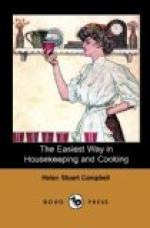Pans made of thick tin, or, better still, of Russia iron, ten inches long, four or five wide, and four deep, make the best-shaped loaf, and one requiring a reasonably short time to bake.
YEAST.
Ingredients: One teacupful of lightly broken hops; one pint of sifted flour; one cupful of sugar; one tablespoonful of salt; four large or six medium-sized potatoes; and two quarts of boiling water.
Boil the potatoes, and mash them fine. At the same time, having tied the hops in a little bag, boil them for half an hour in the two quarts of water, but in another saucepan. Mix the flour, sugar, and salt well together in a large mixing-bowl, and pour on the boiling hop-water, stirring constantly. Now add enough of this to the mashed potato to thin it till it can be poured, and mix all together, straining it through a sieve to avoid any possible lumps. Add to this, when cool, either a cupful of yeast left from the last, or of baker’s yeast, or a Twin Brothers’ yeast cake dissolved in a little warm water. Let it stand till partly light, and then stir down two or three times in the course of five or six hours, as this makes it stronger. At the end of that time it will be light. Keep in a covered stone jar, or in glass cans. By stirring in corn-meal till a dough is made, and then forming it in small cakes and drying in the sun, dry yeast is made, which keeps better than the liquid in hot weather. Crumb, and soak in warm water half an hour before using.
Potato yeast is made by omitting hops and flour, but mashing the potatoes fine with the same proportion of other ingredients, and adding the old yeast, when cool, as before. It is very nice, but must be made fresh every week; while the other, kept in a cool place, will be good a month.
BREAD.
For four loaves of bread of the pan-size given above, allow as follows: Four quarts of flour; one large cup of yeast; one tablespoonful of salt, one of sugar, and one of butter or lard; one pint of milk mixed with one of warm water, or one quart of water alone for the “wetting.”
Sift the flour into a large pan or bowl. Put the sugar, salt, and butter in the bottom of the bread pan or bowl, and pour on a spoonful or two of boiling water, enough to dissolve all. Add the quart of wetting, and the yeast. Now stir in slowly two quarts of the flour; cover with a cloth, and set in a temperature of about 75 deg. to rise until morning. Bread mixed at nine in the evening will be ready to mould into loaves or rolls by six the next morning. In summer it would be necessary to find a cool place; in winter a warm one,—the chief point being to keep the temperature even. If mixed early in the morning, it is ready to mold and bake in the afternoon, from seven to eight hours being all it should stand.
This first mixture is called a sponge; and, if only a loaf of graham or rye bread is wanted, one quart of it can be measured, and thickened with other flour as in the rules given hereafter.




